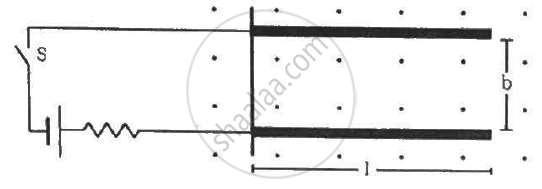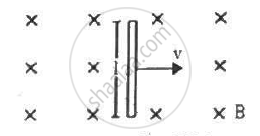Advertisements
Advertisements
प्रश्न
Which one of the following particles cannot be accelerated by a cyclotron?
(A) Electrons
(B) Protons
(C) Deuterons
(D) α- particles
Which one of the following particles cannot be accelerated by a cyclotron?
(A) Protons
(B) Neutrons
(C) α-particles
(D) Deuterons
उत्तर
A cyclotron cannot acceletate the following particles
Electrons
Neutrons
APPEARS IN
संबंधित प्रश्न
Draw a neat labelled diagram for the construction of 'cyclotron'
State the principle of a cyclotron.
If a watch-glass containing a small quantity of water is placed on two dissimilar magnetic poles, then water ______.
Obtain the expression for the cyclotron frequency.
A deuteron and a proton are accelerated by the cyclotron. Can both be accelerated with the same oscillator frequency? Give reason to justify your answer.
A proton and an electron travelling along parallel paths enter a region of uniform magnetic field, acting perpendicular to their paths. Which of them will move in a circular path with higher frequency?
Draw a schematic sketch of a cyclotron. Explain clearly the role of crossed electric and magnetic field in accelerating the charge. Hence derive the expression for the kinetic energy acquired by the particles.
An α-particle and a proton are released from the centre of the cyclotron and made to accelerate.
(i) Can both be accelerated at the same cyclotron frequency?
Give reason to justify your answer.
(ii) When they are accelerated in turn, which of the two will have higher velocity at the exit slit of the does?
Explain the principle and working of a cyclotron with the help of a schematic diagram. Write the expression for cyclotron frequency.
Verify that the units weber and volt second are the same.
If a charged particle kept at rest experiences an electromagnetic force,
(a) there must be an electric field
(b) there must be a magnetic field
(c) both fields cannot be zero
(d) both fields can be non-zero
An electron is projected horizontally with a kinetic energy of 10 keV. A magnetic field of strength 1.0 × 10−7 T exists in the vertically upward direction.
(a) Will the electron deflect towards the right or left of its motion?
(b) Calculate the sideways deflection of the electron while travelling through 1 m. Make appropriate approximations.
Consider a 10-cm long portion of a straight wire carrying a current of 10 A placed in a magnetic field of 0.1 T making an angle of 53° with the wire. What magnetic force does the wire experience?
Figure shows a rod PQ of length 20.0 cm and mass 200 g suspended through a fixed point O by two threads of lengths 20.0 cm each. A magnetic field of strength 0.500 T exists in the vicinity of the wire PQ, as shown in the figure. The wires connecting PQ with the battery are loose and exert no force on PQ. (a) Find the tension in the threads when the switch S is open. (b) A current of 2.0 A is established when the switch S is closed. Find the tension in the threads now.
Two metal strips, each of length l, are clamped parallel to each other on a horizontal floor with a separation b between them. A wire of mass m lies on them perpendicularly, as shown in the figure. A vertically-upward magnetic field of strength B exists in the space. The metal strips are smooth but the coefficient of friction between the wire and the floor is µ. A current i is established when the switch S is closed at the instant t = 0. Discuss the motion of the wire after the switch is closed. How far away from the strips will the wire reach?

A conducting wire of length l, lying normal to a magnetic field B, moves with a velocity v,as shown in the figure. (a) Find the average magnetic force on a free electron of the wire. (b) Due to this magnetic force, electrons concentrate at one end, resulting in an electric field inside the wire. The redistribution stops when the electric force on the free electrons balances the magnetic force. Find the electric field developed inside the wire when the redistribution stops. (c) What potential difference is developed between the ends of the wire?

Answer the following question.
State the underlying principle of a cyclotron. Explain its working with the help of a schematic diagram. Obtain the expression for cyclotron frequency.
Cyclotron frequency of a charged particle having charge q and mass m in a cyclotron producing magnetic field B is ______.
A charged particle is moving in a cyclotron, what effect on the radius of path of this charged particle will occur when the frequency of the ratio frequency field is doubled?
Which of the following is not correct about cyclotron?
A particle of mass m is moving in a circular path of constant radius r such that, its centripetal acceleration ac is varying with time t as ac = k2rt2, where k is a constant. The power delivered to the particle by the forces acting on it is ______.
The life time of muon in the rest frame is 2 × 10-6 sec. A beam of muons emerges from a cyclotron with velocity where c is the velocity of light The mean life of muons observed in the laboratory frame will be ______.
In a cyclotron, a charged particle ______.
